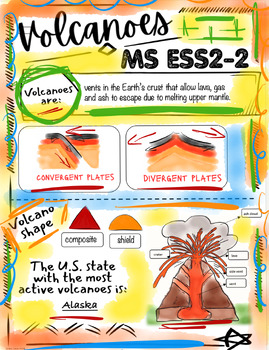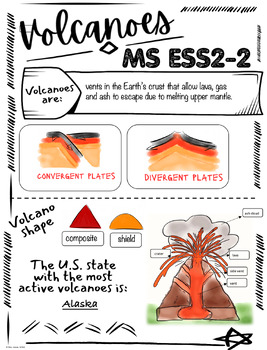Volcanoes Formation Location The Ring of Fire and Tectonic Plates MS ESS2 NGSS
Mrs Lena
578 Followers
Grade Levels
4th - 6th, Homeschool
Subjects
Resource Type
Standards
CCSSRI.5.1
CCSSRI.5.2
CCSSRI.5.4
CCSSRI.5.10
NGSSMS-ESS3-2
Formats Included
- PDF
- Internet Activities
- Easel Activity
Pages
36 pages
Mrs Lena
578 Followers
Easel Activity Included
This resource includes a ready-to-use interactive activity students can complete on any device. Easel by TPT is free to use! Learn more.
Compatible with Digital Devices
The Teacher-Author has indicated that this resource can be used for device-based learning.
Description
Volcanoes MS ESS2-2 NGSS and SC.7.E.6.5 Lesson on formation, types of volcanoes, explosive, creative-effusive, composite, cinder cone and shield volcanoes, parts of a volcano, location with the focus on Hawaiian Kilauea volcano, tectonic plates, hot spots, new vocabulary, post assessment with answer key, and science doodle activity. Printable & Nearpod (integrates with Google Classroom)
The lesson includes:
- What Are Volcanoes? Reading
- The Shape of a Volcano Reading
- Parts of a Volcano Diagram Activity
- Types of Volcanoes - Composite, Cinder Cone and Shield Volcanoes
- Explosive and Creative Effusive Volcanoes Differences
- Landforms Created by Creative Eruptions
- Eruption Style
- Volcano Aftermath
- Locations along tectonic plates
- Hot spots with the focus on Kilauea Volcano in Hawaii
- New Vocabulary
- Extension resources
- Post Lesson Assessment
- Word Search
- Volcano Science Doodle Activity
- Answer Key
- Nearpod Teacher Access is available, please email me for the teacher link at mrslenamed@gmail.com
Similar Resources:
- Weathering and Erosion - Lesson - Pdf & Nearpod Lesson Formats
- Renewable and Non-Renewable Energy - Pdf & Nearpod Lesson
- Rock Cycle - Science - Pdf & Nearpod Lesson - Google Classroom Ready
*************************************************************************************
• Be sure to follow my store to be alerted of new products >> click here
• Don't forget to leave feedback . You will receive TPT credits to be used towards future purchases!
Thanks,
Mrs. Lena, M. Ed.
Total Pages
36 pages
Answer Key
Included
Teaching Duration
1 Week
Report this resource to TPT
Reported resources will be reviewed by our team. Report this resource to let us know if this resource violates TPT’s content guidelines.
Standards
to see state-specific standards (only available in the US).
CCSSRI.5.1
Quote accurately from a text when explaining what the text says explicitly and when drawing inferences from the text.
CCSSRI.5.2
Determine two or more main ideas of a text and explain how they are supported by key details; summarize the text.
CCSSRI.5.4
Determine the meaning of general academic and domain-specific words and phrases in a text relevant to a grade 5 topic or subject area.
CCSSRI.5.10
By the end of the year, read and comprehend informational texts, including history/social studies, science, and technical texts, at the high end of the grades 4–5 text complexity band independently and proficiently.
NGSSMS-ESS3-2
Analyze and interpret data on natural hazards to forecast future catastrophic events and inform the development of technologies to mitigate their effects. Emphasis is on how some natural hazards, such as volcanic eruptions and severe weather, are preceded by phenomena that allow for reliable predictions, but others, such as earthquakes, occur suddenly and with no notice, and thus are not yet predictable. Examples of natural hazards can be taken from interior processes (such as earthquakes and volcanic eruptions), surface processes (such as mass wasting and tsunamis), or severe weather events (such as hurricanes, tornadoes, and floods). Examples of data can include the locations, magnitudes, and frequencies of the natural hazards. Examples of technologies can be global (such as satellite systems to monitor hurricanes or forest fires) or local (such as building basements in tornado-prone regions or reservoirs to mitigate droughts).






